Introduction
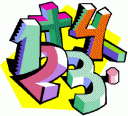
Students in third and fourth grade begin to explore the use of fractions in mathematics. Students will recognize the numerator and the denominator, and understand how to compare different fractions. In third grade, the focus will be on fractions with “like” denominators, and they will move on to “un-like” denominators in fourth grade. Students will add and subtract fractions with denominators up to 12, and learn how to simplify fractions, as well as recognize equivalent fractions
Text Sources
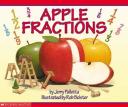
Apple Fractions by Jerry Pallotta
This is a great book for students just learning to recognize and comprehend fractions. Pallotta uses an apple cut up by tiny elves to show halves, thirds, fourths, etc. Students see the differentsizes of fractions in a common and recognizable object, an apple. Though it may not be possible to do in a classroom, it is a great hands-on experience to have students cut an apple (with adult supervision) to match the fractions in the book.
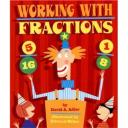
Working with Fractions by David A. Adler
This is a wonderful book to read to a class to learn about different fraction concepts. The brilliant illustrations will keep students interested as fractions are thoroughly discussed. Adler does not only use concrete objects like a cake or pizza, but also includes situations such as music chairs: if you are playing musical chairs with 7 people, and 5 people sit down, then 5/7 of the children are sitting down. The book discusses the way fractions can be found everywhere.
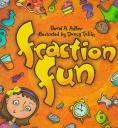
Fraction Fun by David A. Adler
Fraction Fun is a great introductory book. Adler includes equivalent fractions and even adding fractions. Adler includes hands on activities, and his illustrations put students at ease with the new math. Students will compare fractions and see how fractions be equal, less than, or greater than other fractions.
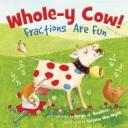
Whole-y Cow: Fractions are Fun by Taryn Souders
This book keeps students engaged without realizing how much they’re learning. Silly illustrations fill the pages, as well as math riddles. Students will try to help the cow figure out math problems, and will discover a love for math along the way. This story can be read to children as young as five, but older students will still enjoy working on the math problems inside.
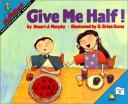
Give me Half! by Stuart J. Murphy
Murphy’s story is great for any students who’ve ever tried to share food with their siblings or friends. Following a brother and sister as they try to share their snacks, students are introduced to different fractions (because no one wants to split evenly!) They learn about equivalent fractions, and are introduced to the word “divide.” Murphy shows some equations such as: 1/2 + 1/2 = 1.
Web Sources
This is a simple online activity for students who are just starting to learn fractions. Set up as an interactive quiz, the site shows students a bar with a portion colored in. Students will type in the correct fraction, and click ok. If they are correct, the quiz will move on to a new example. If they are incorrect, they will be told that their response was “too big” or “too small.” On the bottom of the page, it gives students instructions, as well as a brief overview of fractions. It identifies the numerator and denominator, and shows how to type the fraction into the quiz.
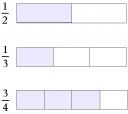
This fun site sets up fractions as a game. Balloons come onto the screen, and each balloon has a fraction and a model on it. Students must pop the balloon in order from smallest to greatest. This is a great opportunity to think on their feet. The site is very easy to use, and the game has three levels, so students can be challenged if they are ready.
This sight helps students practice the greater than, less than, and equal sign. Students must compare fractions and use multiple choice answers to decide if the fractions are equivalent or not. The site uses small fractions, and is very easy for students to understand. This could be used as an assessment, a homework assignment, or practice.
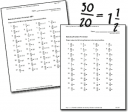
Fun with Fractions and Decimals
This is a fun start for students who are transitioning from fractions to decimals. Set up like the classic board game Shoots and Ladders, students must use multiple choice answers to convert a fraction into decimal form. If they get the answer right, they can “roll the dice” and move on the board. Just like shoots and ladders, they might move up a later, or risk sliding down a shoot. It’s an exciting and interactive way for students to practice math. It can even be used as partner game.
One of my personal favorite resources for kids. This game allows students to pick how many cookies to have, and how many friends. Then, they must divide the cookies evenly between friends. The cookies do not always split up evenly, so students have cookie cutters with various fraction bars to cut the cookies up. It surprisingly involves a lot of critical thinking, as students have to decide how many cookies it is necessary to cut up. It allows the student a lot of freedom as they practice fractions.
Teacher Resources
Funny and Fabulous Fraction Stories by Dan Greenberg
This book is full of math stories and problems that students will love. The reproducibles are perfect for students in third or fourth grade who are learning to recognize fractions and use them in equations. There are worksheets, stories, and lessons for teachers to use with their class. The book is an incredible resource for teachers of many grades.
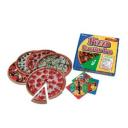
A great game to have in the classroom. There are seven games included in this set, all involving the introduction of fractions. It can be used for many different levels and skills. It is a great way to use such a recognizable thing like pizza without having to bring food into the classroom.
This is a staple need for every math classroom. Fraction tiles are great to have because students can move them around and compare their physical sizes as they do math problems including fractions. 
Another great activity for teachers to have available in their classroom. These puzzles have four circles that can be filled in with any pie slices – the trick is to use the correct fractions. Students will need to understand equivalent fractions, and they can practice their addition as they predict which fractions will complete the puzzle.
